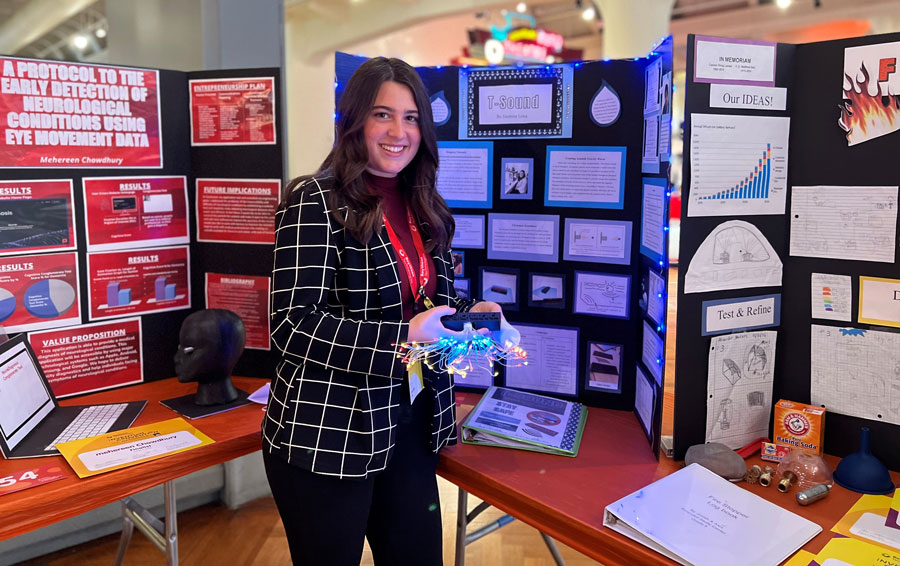‘Solving problems is her thing.’ Local student wins award for invention to prevent tsunamis
Published at
IDAHO FALLS – A local high school student could potentially save lives with her award-winning idea for the invention of “T-Sound”.
Jasmine Lima, 15, won a national award in early June for her idea for an invention that aims to dissolve the waves created in tsunamis.
“T-Sound is an advanced tsunami protection device,” says Jasmine, a ninth-grader at American Heritage Charter School. “It uses a dual system of acoustic gravity waves to neutralize the energy of a tsunami. Acoustic gravity waves are basically sound waves that travel through the water. If you throw a rock into the water, it’s going to produce acoustic gravity waves.”
Scientists have been studying acoustic gravity waves for tsunami detection for many years. Jasmine is switching that focus from detection to prevention.
The idea is that when acoustic gravity waves are sent out by T-Sound, they will connect with a tsunami and absorb that energy, neutralizing the tsunami and saving impacted people from catastrophic damage.
Out of over 150,000 contenders, Jasmine placed second in her age category on June 3 at the National Invention Convention held at the Henry Ford Museum of American Innovation in Dearborn, Michigan. At the competition, Jasmine presented a non-working, 3-D printed model of what she envisions an actual prototype of T-Sound would look like.
Sponsored partly by Idaho National Laboratory, the Invention Convention aims to generate excitement and possibility among young inventors and give them a platform to present ideas that could change the world.
“INL is a massive sponsor of Invention Convention, at least at the state-wide level,” says Tony Lima, Jasmine’s father. “I think it’s important to recognize the tremendous amount of investments and time that their education leaders and the STEM (science, technology, engineering and mathematics) leadership are personally investing.”
RELATED | Encouraging young Edisons: Invention convention gets support from INL
This is not the first time that Jasmine has qualified for a national bid at the competition. Two years ago, Jasmine competed virtually, presenting her invention of the “Security Stirrup,” a device that allows horseback riders who have been bucked from a horse to disconnect and avoid being dragged.
Jasmine first got involved with Invention Convention while attending White Pine Charter School. Now, a high-school student at American Heritage, Jasmine, with the help of her teacher, Alaysha Whitworth, has participated in nationals twice.
“When Jasmine made her first national bid, we were like, ‘Holy cow, this is amazing!’, says Whitworth, a science teacher and STEM club advisor at American Heritage. “She definitely has the talent and drive to do it. She puts her heart and soul into everything that she does. It’s her passion and she definitely has a knack for it. Solving problems is her thing.”

Jasmine, along with her family, spent the beginning of the COVID-19 pandemic in Hawaii, where the idea for T-Sound was born.
Planning to do some surfing, Jasmine and her father woke up one morning to discover that there was a tsunami warning, meaning that their hopes for a great day of surfing the waves were quashed.
“In the town where we were (supposed to go surfing), there’s a one-lane bridge in and out of that town,” says Jasmine. “So I was thinking, ‘If we were to have gone surfing that day, and the tsunami would’ve hit, there was only a one-lane bridge to evacuate everyone.’”
The real meat of the idea came about when the family decided to go boating, and Jasmine noticed that waves from other boats were crashing into the boat she was on, giving her the idea to use electrical pulses to neutralize them.
“I was researching that idea, and that’s when I connected it with my experience with the tsunami,” says Jasmine. “I kind of realized I can take this smaller idea I have to just stop some waves on some boats to actually stop a natural disaster.”
Throughout Jasmine’s journey with the idea for T-Sound, she has been working with the world’s leading experts to try and one day make it possible to develop an actual, full-size working model.
“I reached out to the leading expert in the fluid particles and the acoustic gravity waves field, Dr. Usama Kadri, and he was instrumental absolutely in creating and helping me develop T-sound,” says Jasmine.
With the help of Kadri, a senior lecturer in applied mathematics at Cardiff University in Wales, the two determined how T-Sound would work on a large scale, what it would cost, and even how they could implement it in low-income areas. To make a working prototype, they imagine the funding would take between $20,000 and $50,000.
“Really what T-sound needs is more funding and more research for it,” says Jasmine.
Jasmine hopes to be able to further pursue research during her high school years and even into college.
When asked what her plans are for the next couple of years, Jasmine stated, “I love to learn, so I’m just going to continue learning about this project and going to school and college, and I’m just going to keep on keeping on.”
Tony, who has supported his daughter throughout her inventive journey, says that he is proud of his daughter’s perseverance and tenacity.
“Stopping a natural disaster? My goodness. Even the (prevention of the) loss of one life is worth it,” says Tony. “We think that there’s great possibility with a working model, and I think that this is something that is in the not-too-distant future.”


